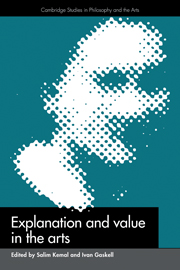Book contents
- Frontmatter
- Contents
- List of contributors
- Editors' acknowledgments
- 1 Interests, values, and explanations
- 2 Fiction and reality in painting
- 3 Franz Kafka: the necessity for a philosophical interpretation of his work
- 4 On relocating ethical criticism
- 5 Explanation and value: what makes the visual arts so different, so appealing?
- 6 Is art history?
- 7 Objectivity and valuation in contemporary art history
- 8 Fullness and parsimony: notes on creativity in the arts
- 9 Principles of a sociology of cultural works
- 10 Althusser and ideological criticism of the arts
- 11 Film, rhetoric, and ideology
- Index
11 - Film, rhetoric, and ideology
Published online by Cambridge University Press: 24 February 2010
- Frontmatter
- Contents
- List of contributors
- Editors' acknowledgments
- 1 Interests, values, and explanations
- 2 Fiction and reality in painting
- 3 Franz Kafka: the necessity for a philosophical interpretation of his work
- 4 On relocating ethical criticism
- 5 Explanation and value: what makes the visual arts so different, so appealing?
- 6 Is art history?
- 7 Objectivity and valuation in contemporary art history
- 8 Fullness and parsimony: notes on creativity in the arts
- 9 Principles of a sociology of cultural works
- 10 Althusser and ideological criticism of the arts
- 11 Film, rhetoric, and ideology
- Index
Summary
INTRODUCTION
Until recently, the major recurring question of value that confronted film theorists was whether film could be an art, and, thus, a source of artistic value. In the earliest stages of film theory, this worry was made urgent by the existence of certain anti-mimetic prejudices with respect to photography. For photography was regarded to be a purely mechanical process of recording, and, hence, essentially inartistic. Consequently, film, whose central constituent is photographic, likewise found its artistic credentials under fire.
As a result, the self-appointed task of members of the first generation of film theorists, like Rudolph Arnheim, was to demonstrate, often at length, the ways in which film could diverge expressively from what was thought of as the mere reproduction of reality. And, in the course of these demonstrations, film aesthetics was born. For in showing the ways in which cinematic devices creatively reconstructed pro-filmic events, an inventory of artistic structures was enumerated.
Moreover, the task of establishing the artistic potentials of film proceeded under certain constraints. For it was thought that if film had genuinely artistic potentials, they would have to be of a uniquely cinematic variety. That is, film would not be shown to be an art were it simply mimicking theater. Rather, it had to be established that film had some range of essentially cinematic effects, possessed by no other art forms, which, at the same time, performed some demonstrably artistic function (such as, for example, expression).
- Type
- Chapter
- Information
- Explanation and Value in the Arts , pp. 215 - 237Publisher: Cambridge University PressPrint publication year: 1993
- 28
- Cited by

